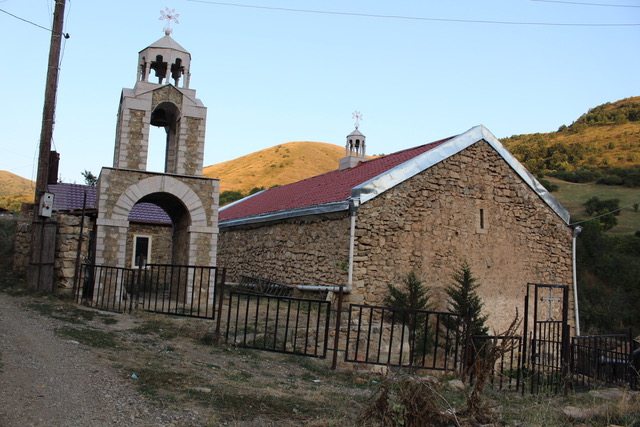Two villages, Hin Tagher (Taghler) and Mets Tagher (Taghler), in Artsakh’s Hadrut district, are listed in Discovering Paradise, Karabagh Guide as interesting sites featuring examples of Artsakh’s history and civil architecture. I have previously written about Mets Tagher.
The road to Mets Tagher, though shown on our map as a secondary road, was easily passable. So, my friend and I assumed the road to Hin Tagher would be easily passable as well, neglecting the fact that the village appeared to be near the peak of Mount Dizpayt.
It was mid-afternoon when we turned off the main road onto a dirt road ascending towards the village. The sign pointing towards Hin Tagher indicated 30 km, just under 20 miles, though it seemed much longer. To our right was the slope of Dizpayt, reaching up to 1.4-1.5 miles above sea level. The slope on the other side of the road often steeply descended into valleys, some of which seemed bottomless. On two or three occasions small roads, really paths, branched to the left with small signs pointing to other villages, which we did not have time to explore. As we neared a peak in the road, we noticed the dust cloud of a red SUV trailing behind us.
We stopped to refill our water bottles at a spring along the roadside when the SUV with Russian plates caught up to us. An Armenian couple from Russia was visiting the husband’s grandmother who lived in the village. During the previous year’s visit, the husband had hiked from the village to the Katarovank monastery on the summit of Mount Dizpayt. He met a man there whose beard hung down to his waist. The bearded man had previously climbed to the monastery, vowing not to return until someone else visited the site. I have no idea how long he was there or how he survived.
A monastery was initially established atop Mount Dizpayt in the 4th century and subsequently destroyed. The current structure is dated 17th century.
In the village we stopped at the Surb Amenaprkitch church (ca 1400) that had recently been renovated; I’m guessing by a villager who left Armenia, became financially successful, and renovated the church for his village. Opposite the church, two women were seated with their grandchildren. Since it appeared that many of the houses had not been occupied for some time, I asked the women what the population of Hin Tagher was. “Not many” was the answer, which is frequently the response to this question in many small, remote villages.
When I asked if the village was purely Armenian before the war or if it was a mixed Armenian-Azerbaijani village, they replied that this was Armenian. But, they added, during the war “we were waiting for the Turks from Jibrael to come and kill us all!” Jibrael was a major Azerbaijani stronghold in the valley below.
I surmise that given the economic conditions, most of the young men probably were away, having either left the village for work or were in the army, but I don’t know this for sure. Fortunately, the women’s fear was never realized. Later when mentioning this to a friend from Artsakh with connections to the military, he indicated that this would never have happened. Armenian forces had helicopters and troops stationed at strategic locations, prepared to interdict any enemy forces endangering these villages.
We spent less that an hour in the village. It was late in the afternoon and we wanted to get off the mountain before it got dark, which occurs quickly in the mountains. The two women offered us refreshments and even invited us to stay until the following morning, but we had to decline their hospitality. We were obliged to check out of our hotel in Shushi the next morning and return our rental car in Yerevan. Hopefully we’ll be able to revisit Hin Tagher.
Source: Armenian Weekly
Link: Unseen Armenia: Hin Tagher




